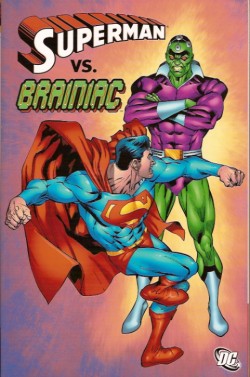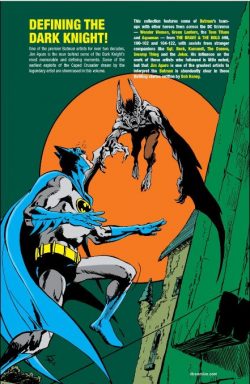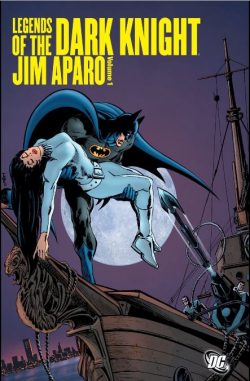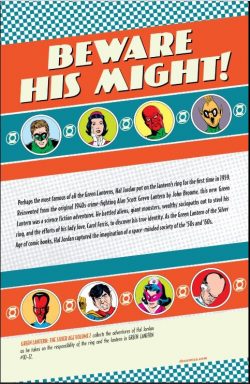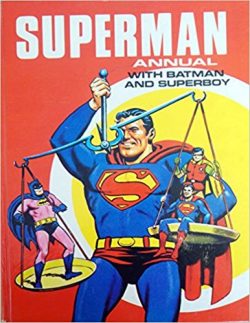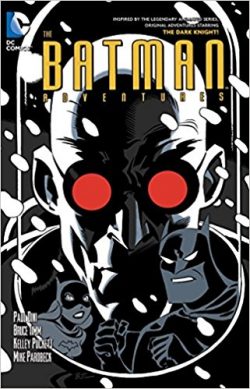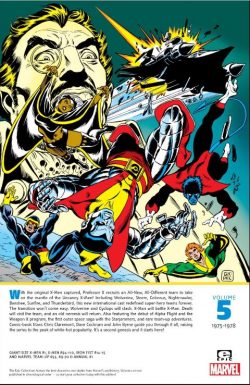
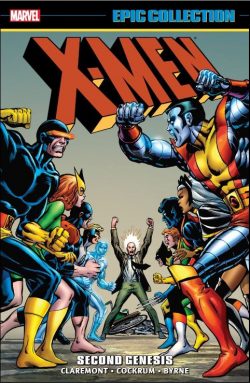
By Len Wein, Chris Claremont, Bill Mantlo, Bonnie Wilford, Dave Cockrum, Bob Brown, Tony DeZuñiga, John Byrne, Sal Buscema & various (DC Comics)
ISBN: 978-1-3029-0390-9
In the autumn of 1963 The X-Men #1 introduced Scott (Cyclops) Summers, Bobby (Iceman) Drake, Warren (Angel) Worthington, Jean (Marvel Girl) Grey and Hank (The Beast) McCoy: very special students of Professor Charles Xavier.
The teacher was a wheelchair-bound telepath dedicated to brokering peace and integration between the masses of humanity and the emergent off-shoot race of mutants dubbed Homo Superior; considered by many who knew him as a living saint.
After nearly eight years of eccentrically spectacular adventures the mutant misfits virtually disappeared at the beginning of 1970 during another periodic downturn in superhero comics sales. Just like in the closing years of the 1940s, mystery men faded away as supernatural mysteries and traditional genre themes once more dominated the world’s entertainment fields…
Although their title returned at the end of the year as a cheap reprint vehicle, the missing mutants were reduced to guest-stars and bit-players throughout the ongoing Marvel universe, whilst the bludgeoning Beast was opportunistically transformed into a scary monster to cash in on the horror boom.
Then, with sales of the spooky stuff subsequently waning in 1975, Marvel Editor-in-Chief Roy Thomas green-lighted a bold one-shot as part of the company’s line of Giant-Size specials and history was made…
This fabulous mass-market collection (in trade paperback and eBook editions) is perfect for newbies and neophytes, celebrating the revival and unstoppable march to market dominance through the exuberant and pivotal early stories: specifically, Giant Size X-Men #1, issues #94-110 of the definitely “All-New, All-Different†X-Men, as well as guest appearances in Iron Fist #14-15, Marvel Team Up #53, 69-70 and Marvel Team Up Annual #1, collectively and cumulatively spanning May 1975 to June 1978.
Tracing the reinvigorated merry mutants from young, fresh and delightfully under-exposed innovations to the beginnings of their unstoppable ascendancy to ultimate comicbook icons, in their own title and through an increasingly broad clutch of guest shots, the epic voyage begins without pause or preamble, in a classic mystery monster mash from Giant Size X-Men #1.
Len Wein & Dave Cockrum (the latter a red-hot property following his stint reviving DC’s equally eclectic fan-fave super-team The Legion of Super-Heroes) detailed in ‘Second Genesis!’ how the original squad – all but new Avengers recruit The Beast – had been lost in action…
With no other choice Xavier is forced to scour Earth and the entire Marvel Universe for replacements…
To old foes-turned-friends Banshee and Sunfire is added a one-shot Hulk adversary dubbed the Wolverine, but the bulk of time and attention is lavished upon original creations Kurt Wagner, a demonic-seeming German teleporter codenamed Nightcrawler; African weather “goddess†Ororo Monroe – AKA Storm, Russian farm-boy Peter Rasputin who turns into a living steel Colossus and bitter, disillusioned Apache superman John Proudstar who is cajoled into joining the makeshift squad as Thunderbird.
The second chapter of the epic introductory adventure ‘…And Then There Was One!’ reintroduces battered, depleted but unbowed team-leader Cyclops who swiftly drills the newcomers into a semblance of readiness before leading them into primordial danger against the monolithic threat of ‘Krakoa… the Island That Walks Like a Man!’
Overcoming the phenomenal terror of a rampaging rapacious mutant eco-system and rescuing the “real†team should have led to a quarterly Giant-Size sequel, but so great was the fan response that the follow-up adventure was swiftly reworked into a 2-part tale for the rapidly reconfigured comicbook which became a bimonthly home to the new team.
X-Men #94 (August 1975) began ‘The Doomsmith Scenario!’ – plotted by Editor Wein, scripted by Chris Claremont and with Bob McLeod inking man-on-fire Cockrum – in a canny Armageddon-shocker with a newly pared-down strike-squad deprived of Sunfire and the still-recuperating Marvel Girl, Angel, Iceman, Havok and Lorna Dane. The neophytes are called in by the Beast to stop criminal terrorist Count Nefaria starting an atomic war.
The insidious mastermind has conquered America’s Norad citadel with a gang of artificial superhumans and accidentally escalated a nuclear blackmail scheme into an inescapable countdown to holocaust, leaving the untrained, unprepared mutants to storm in to save the world in epic conclusion ‘Warhunt!‘ (inked by Sam Grainger).
One of the new team doesn’t make it back…
X-Men #96 saw Claremont take charge of the writing (albeit with some plotting input from Bill Mantlo) for ‘Night of the Demon!’ Guilt-wracked Cyclops blames himself for the loss of his team-mate, and in his explosive rage accidentally unleashes a demonic antediluvian horror from Earth’s primordial prehistory for the heroes-in-training to thrash.
The infernal Nagarai would return over and again to bedevil mankind, but the biggest innovation in this issue is the introduction of gun-toting biologist/housekeeper Moira MacTaggert and the first inklings of the return of implacable old adversaries…
A long-running, cosmically-widescreen storyline began in #97 with ‘My Brother, My Enemy!’ as Xavier – tormented by visions of interstellar war – tries to take a vacation, just as Havok and Lorna (finally settling on superhero nom de guerre Polaris) attack: apparently willing servants of a mysterious madman using Cyclops’ old undercover alter ego Eric the Red.
The devastating conflict then segues into a spectacular 3-part yarn, as pitiless robotic killers return under the hate-filled auspices of mutantophobic Steven Lang and his mysterious backers in Project Armageddon. The action opens with #98’s ‘Merry Christmas, X-Men…the Sentinels Have Returned!’
With coordinated attacks capturing semi-retired Marvel Girl plus Wolverine, Banshee and Xavier, Cyclops and the remaining heroes co-opt a space shuttle and storm Lang’s orbital HQ to rescue them in ‘Deathstar Rising!’ (inked by Frank Chiaramonte): another phenomenal all-action episode.
The saga concludes on an agonising cliffhanger with the 100th issue anniversary tale. ‘Greater Love Hath no X-Man…’ (with Cockrum inking his own pencils) sees the new X-Men apparently battle the original team before overturning Lang’s monstrous schemes forever. However, their catastrophic clash destroys the only means of escape and, as a gigantic solar flare threatens to eradicate the satellite-station, their only chance of survival means certain death for another X-Man.
As #101 unfolded, scripter Claremont & artist Cockrum were on the on the verge of utterly overturning the accepted status quo of women in comics forever…
Led by field-leader Cyclops, the team now consisted of old acquaintance and former foe Sean “Banshee†Cassidy, Wolverine, and new creations Nightcrawler, Storm, Colossus and part-timer Jean Grey still labouring under the nom-de guerre Marvel Girl… but not for much longer…
‘Like a Phoenix from the Ashes’ (Chiaramonte inks) sees a space-shuttle cataclysmically crash into Jamaica Bay. The X-Men had safely travelled in a specially-shielded chamber but Marvel Girl had manually piloted the vehicle, unprotected through a lethal radiation storm…
As the mutants escape the slowly sinking craft, a fantastic explosion propels the impossibly alive Jean into the air, clad in a strange gold and green uniform and screaming that she is “Fire and Life Incarnate… Phoenix!â€
Immediately collapsing, the critically injured girl is rushed to hospital and a grim wait begins.
Unable to explain her survival and too preoccupied to spare time for teaching, Xavier packs Banshee, Nightcrawler, Wolverine, Storm and Colossus off to the Irish mutant’s home in County Mayo for a vacation, blissfully unaware that Cassidy Keep has been compromised and is now a deadly trap for his new students…
Within the ancestral pile, Sean’s mutant cousin Black Tom has usurped control of the manor and its incredible secrets before – at Eric the Red’s behest – contriving an inescapable ambush, assisted by an old X-Men enemy.
‘Who Will Stop the Juggernaut?’ (Grainger inks) sees the inexperienced heroes in over their heads and fighting for their lives, but still finds room to reveal the origins of Storm and provide an explanation for her crippling claustrophobia, before ‘The Fall of the Tower’ explosively ends the tale with mutant heroes and the Keep’s Leprechaun colony (no, really!) uniting to expel the murderous usurpers.
Although still bi-monthly at the time, the series kicked into confident top gear with ‘The Gentleman’s Name is Magneto’ as the weary warriors then divert to Scotland to check on Moira MacTaggert’s island lab: a secret facility containing myriad mutant menaces the X-Men have previously defeated.
It’s a very bad move since the ever-active Eric has restored the dormant master of magnetism to full power. The mutant terrorist had been turned into a baby – a strangely commonplace fate for villains in those faraway days – but he was all grown up again now and indulging in one last temper tantrum…
Freshly arrived from America, Moira and Cyclops are only just in time to lead a desperate, humiliating retreat from the triumphant Master of Magnetism. Scott doesn’t care: he realises the entire affair has been a feint to draw the heroes away from Xavier and Jean…
He needn’t have worried. Although in ‘Phoenix Unleashed’ (inks by Bob Layton) Eric orchestrates an attack by Firelord – a cosmic flamethrower and former herald of Galactus much like the Silver Surfer – Jean is now fully evolved into a being of unimaginable power who readily holds the fiery marauder at bay…
In the interim a long-standing mystery is solved as the visions which have haunted and tormented Xavier are revealed as a psychic connection with a runaway princess from a distant alien empire.
Lilandra of the Shi’ar had rebelled against her imperial brother and, whilst fleeing, had somehow telepathically locked onto her trans-galactic soul-mate Charles Xavier. As she made her circuitous way to Earth, embedded Shi’ar spy Shakari had assumed the role of Eric the Red and attempted to remove Lilandra’s potential champion before she arrived…
During the blistering battle which follows the X-Men’s dramatic arrival, Shakari snatches up Lilandra and drags her through a stargate to their home galaxy, and with the entire universe imperilled, Xavier urges his team to follow. All Jean has to do is re-open a wormhole to the other side of creation…
A minor digression follows as overstretched artist Cockrum gains a breather via a fill-in “untold†tale of the new team featuring an attack by psychic clones of the original X-men. ‘Dark Shroud of the Past’ is a competent pause by Mantlo, Bob Brown & Tom Sutton, set inside a framing sequence from Cockrum.
The regular story resumes in a wry tribute to Star Trek as ‘Where No X-Man Has Gone Before!’ (Claremont, Cockrum & Dan Green) finds the heroes stranded in another galaxy where they meet and are beaten by the Shi’ar Imperial Guard (an in-joke version of DC’s Legion of Super Heroes in the inimitable Cockrum manner), until bold interstellar rebel freebooters the Starjammers bombastically arrive to turn the tables once again whilst uncovering a mad scheme to unmake the fabric of space-time.
Lilandra’s brother Emperor D’Ken is a deranged maniac who wants to activate a cosmic artefact known alternatively as the M’Kraan Crystal and “the End of All that Is†in his quest for ultimate power. He’s also spent time on Earth in the past and played a major role in the life of one of the X-Men…
This tale (from issue #107) was Cockrum’s last for years. He would eventually return to replace the man who replaced him. John Byrne not only illustrated but also began co-plotting the X-tales and, as the team roster expanded, the series rose to even greater heights. It would culminate in the landmark Dark Phoenix storyline which saw the death of arguably the book’s most beloved and imaginative character and the departure of the team’s heart and soul. The epic cosmic saga also seemed to fracture the epochal working relationship of Claremont and Byrne.
Within months of publication they went their separate ways: Claremont staying with the mutants whilst Byrne moved on to establish his own reputation as a writer on series such as Alpha Flight, Incredible Hulk and especially his revolutionised Fantastic Four…
Here though, the X-Men and Starjammers battle the Crystal’s astoundingly deadly automated guardians, as this final chapter depicts the newly puissant Phoenix literally saving Reality in a mind-blowing display of power and skill.
Trapped inside a staggering other-realm, and appalled and enthralled by the intoxicating, addictive nature of her own might, Phoenix rewove the fabric of Reality and for an encore brought the heroes home again.
The conclusion of this ambitious extended saga was drawn by Byrne and inked by Terry Austin and their visual virtuosity was to become an industry bench-mark as the X-Men grew in popularity and complexity.
However, even though the bravura high-octane thrills of ‘Armageddon Now’ seem an unrepeatable high-point, Claremont & Byrne had only started. The best was still to come, but it precluded ending their other ongoing collaboration: a mystic martial arts thriller…
From Iron Fist #14, ‘Snowfire’ – inked by Dan Green – finds masked marvel Danny Rand and his combat colleague Colleen Wing running for their lives in arctic conditions after a vacation retreat to a palatial Canadian Rockies estate is ruined by a criminal raid.
Leading the plundering gang is deadly mercenary Sabretooth. Despite being rendered temporarily blind, the K’un Lun Kid ultimately defeats the mutant marauder, but his fiercely feral foe would return again and again to bedevil both Danny and the X-Men…
With Claremont & Byrne increasingly absorbed by their stellar collaboration on the revived and resurgent adventures of Marvel’s mutant horde, Iron Fist #15 (September 1977) was their last martial arts mash-up for a while. The series ended in spectacular fashion as, through a comedy of errors, Danny stumbles into a morass of misunderstanding and ends up battling the recently returned galaxy rovers Wolverine, Colossus, Nightcrawler, Banshee, Storm and Phoenix in ‘Enter, the X-Men’.
In X-Men #109’s ‘Home Are the Heroes!’ (Claremont, Byrne & Austin) Wolverine finally begins to develop a back-story and some depth of character whilst technological wonder Weapon Alpha attacks the recuperating team in an attempt to force the enigmatic Logan to rejoin the Canadian Secret Service.
Renamed Vindicator Alpha would later return leading Alpha Flight – a Canadian government sponsored super-team which would eventually graduate to their own eccentric high-profile series.
Somewhat out of chronological sequence, this is followed here by an extra-length exploit from Marvel Team Up Annual #1 (1976 and by Mantlo, Sal Buscema & Mike Esposito, from a plot by Mantlo, Claremont & Bonnie Wilford).
‘The Lords of Light and Darkness!’ features Spider-Man and newly minted X-Men Storm, Banshee, Wolverine, Nightcrawler, Colossus, Phoenix and Cyclops assisting Charles Xavier in combatting a pantheon of scientists mutated by atomic accident and elevated to the ranks of gods.
Like most deities, these puissant ones believe they know what is best for humanity and don’t like being disabused of the notion…
Mantlo then teamed with Byrne & Frank Giacoia to bring closure to a tale begun – and left hanging – in Marvel Premiere #31.
Set minutes after the Annual, Marvel Team Up #53 (January 1977) reveals a ‘Nightmare in New Mexico!’ as Spider-Man says goodbye to the X-Men and hello to The Hulk and troubled gene-splicing experiment Woodgod after the tragic bio-construct flees from corrupt Army Colonel Del Tremens. As Tremens tried to suppress the calamitous crisis and his own indiscretions by killing everybody, the final scene sees the webspinner trapped in a rocket and blasted into space…
The tale by Mantlo, Byrne & Frank Giacoia has very little to do with the X-Men, other than a rather gratuitous overlap and ends here without resolution, but still looks pretty damn good after all these years…
In X-Men #110 (April 1978) Claremont, and illustrators Tony DeZuñiga & Cockrum then detail ‘The “Xâ€-Sanction!’: a rather limp and hasty fill-in as cyborg mercenary Warhawk infiltrates the Xavier mansion in search of “intel†for a mysterious, unspecified master… before getting his shiny silver head handed to him…
This initial compendium of uncanny X-episodes wraps up with the contents of Marvel Team Up #69 and 70 (May & June 1978) as in ‘Night of the Living God!’ (Claremont, Byrne & by Ricardo Villamonte) Spider-Man clashes with Egyptian-themed thieves and is drawn into the perpetual duel between cosmic-powered X-Man Havoc and his nemesis the Living Monolith.
When the battle turns against the heroes it requires the might of Thor to stop the ravening astral menace in the concluding chapter ‘Whom Gods Destroy!’ (inked by Tony DeZuñiga)…
Following the cover of 1975’s all-reprint Giant-Size X-Men #2, this volume concludes with a glorious and revelatory selection of extras including John Romita’s original design sketches for Wolverine; Byrne’s first X-Man work (a puzzle from Marvel Fanzine F.O.O.M. #7) and design material from Cockrum’s DC Comics proposal The Outsiders (the Legion of Super-Heroes spin-off he retooled to create Nightcrawler, Storm, Phoenix and the other New X-Men). There are even unused Cockrum pencil pages, initial sketches for the Starjammers, costume upgrades for Angel, the cover art for X-themed The Comic Reader #145, and model sheets for Nightcrawler, Storm, Phoenix and Colossus.
Further treasures are Gil Kane’s cover sketch and original art for Giant-Size X-Men #1, original Cockrum pages from GSXM #1 and F.O.O.M. #10 (the all-X-Men issue), articles from the fanzine – Mutation of the Species, X-Men! X-Men!. Read All About ‘Em! – a pin-up by Don Maitz, X-Men X-posé and spoof strip ‘EggsMen’; unused pages by Bob Brown and previous collection covers by Kane and Cockrum given a painted make-over by Dean White.
Entertaining, groundbreaking and incredibly intoxicating, these adventures are an invaluable and crucial grounding in contemporary fights ‘n’ tights fiction no fan or casual reader can be allowed to ignore.
© 1975, 1976, 1977, 1978, 2017 Marvel Characters, Inc. All rights reserved.
